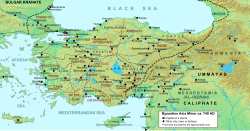Battle of Akroinon
| Battle of Akroinon | |||||||
|---|---|---|---|---|---|---|---|
| Part of the Arab–Byzantine Wars | |||||||
 Map of Anatolia (Asia Minor) in 740 AD. Akroinon is located at the center of the western edge of the central Anatolian plateau |
|||||||
|
|||||||
| Belligerents | |||||||
| Umayyad Caliphate | Byzantine Empire | ||||||
| Commanders and leaders | |||||||
|
Abdallah al-Battal † Al-Malik ibn Shu'aib † |
Leo III Constantine V |
||||||
| Strength | |||||||
| 20,000 | unknown | ||||||
| Casualties and losses | |||||||
| 13,200 | unknown | ||||||
The Battle of Akroinon was fought at Akroinon or Akroinos (near modern Afyon) in Phrygia, on the western edge of the Anatolian plateau, in 740 between an Umayyad Arab army and the Byzantine forces. The Arabs had been conducting regular raids into Anatolia for the past century, and the 740 expedition was the largest in recent decades, consisting of three separate divisions. One division, 20,000 strong under Abdallah al-Battal and al-Malik ibn Shu'aib, was confronted at Akroinon by the Byzantines under the command of Emperor Leo III the Isaurian (r. 717–741) and his son, the future Constantine V (r. 741–775). The battle resulted in a decisive Byzantine victory. Coupled with the Umayyad Caliphate's troubles on other fronts and the internal instability before and after the Abbasid Revolt, this put an end to major Arab incursions into Anatolia for three decades.
Since the beginning of the Muslim conquests, the Byzantine Empire, as the largest, richest and militarily strongest state bordering the expanding Caliphate, had been the Muslims' primary enemy. Following the disastrous Battle of Sebastopolis, the Byzantines had largely confined themselves to a strategy of passive defence, while the Muslim armies regularly launched raids into Byzantine-held Anatolia. Following their failure to capture the Byzantine capital, Constantinople, in 717–718, the Umayyads for a time diverted their attention elsewhere. From 720/721, however, they resumed these expeditions in a regular pattern: each summer one or two campaigns (pl. ṣawā'if, sing. ṣā'ifa) would be launched, sometimes accompanied by a naval attack and sometimes followed by winter expeditions (shawātī). These were no longer aimed at permanent conquest but rather large-scale raids, plundering and devastating the countryside and only occasionally attacking forts or major settlements. The raids of this period were also largely confined to the central Anatolian plateau (chiefly its eastern half, Cappadocia), and only rarely reached the peripheral coastlands.
...
Wikipedia
